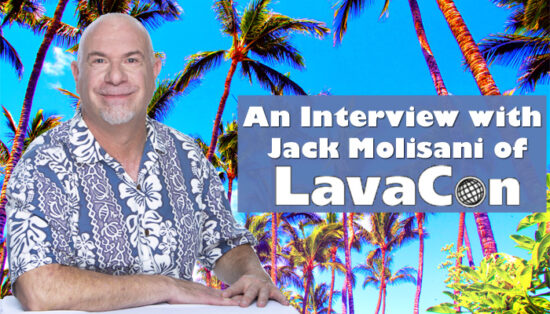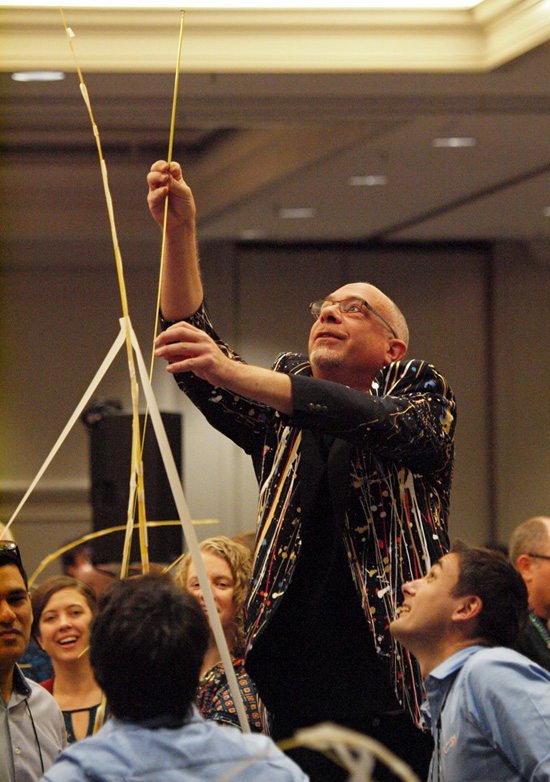
One of my favorite technical communication conferences is LavaCon, hosted annually by its ebullient host and organizer Jack Molisani. I’ve been heading to them since at least 2015, and the location of the venues has always been fun (places like New Orleans and Las Vegas, to name a couple), and perhaps in part because of the cool locations for the conference, LavaCon has the knack of attracting some truly interesting speakers to its main stage. Recently I had the chance to interview the LavaCon master-of-ceremonies Jack Molisani himself for DITAWriter.com.
A Special Offer: DITAWriter readers can register for LavaCon using the referral code #ditaWriter for $100 off conference tuition: https://lavacon.org/2020
DITAWriter: Could you tell me a bit about your history with LavaCon?
Molisani: Back in 1998, I was attending Leadership Day at the Society for Technical Communication’s annual summit, and someone pointed out that it was a shame that none of the Pacific Rim chapters got to attend their own regional conferences, because (at the time) the regional conferences were held on the mainland US.
Someone suggested we have a combined Region 7/Region 8 conference and hold it in a central location like Honolulu. I shot my hand up and said, “I’ll run that one!”
We had the STC Region 7/8 Pan-Pacific Conference in the fall of 2020, and it was an incredible success. Our break-even point was 140 attendees; 560 showed up!
This was supposed to be a one-time event, but at the end everyone was saying, “I can’t wait until next year!” and “I can’t wait until the next one!”
I thought “Hmmm, maybe there’s an opportunity here,” so I started my own conference in Hawaii (that’s why it’s called “LavaCon.”).
Having the conference on various Hawaiian Islands worked until the recession of 2008, after which people didn’t have the travel or training budget to fly to Hawaii. In response, I moved my conference to the mainland US—but I wanted to keep the “aloha spirit” LavaCon was known for.
We normally featured local Hawaiian food, local culture, local music. I wanted to continue that, so I went to fun, walkable cities that are know for their food, music, and culture. Cities like, Austin, Portland, and New Orleans. (Believe me, there is no other city in the US with as much local food, music, and culture than New Orleans!)
DITAWriter: Thanks to Covid, a lot of conferences have had to go virtual, including LavaCon. What’s LavaCon got to offer this year for its virtual attendees?
Molisani: I am very happy to report that we are continuing the LavaCon attendee experience that we are known for, starting with an amazing speaker line-up. This year’s featured speakers include content thought leaders from NBCUniversal, Netflix, Google, Microsoft, LinkedIn, Twitter, and more!
LavaCon is known for being a conference where you can “find your tribe,” so there will be plenty of opportunities for networking and after-hours socializing.
DITAWriter: How hard was it to move LavaCon to be a fully virtual conference this year? And when did you make the decision to go down this path, instead of say, canceling it for this year?
Molisani: Oh wow. That is a very complex question with a many-faceted answer. I’ll do my best to keep it short!
LavaCon has had a live virtual track for many years, produced by the amazing Phylise Banner. Phylise is a Virtual Experience Designer by profession and teaches such at the university level. There was never a question if we could go 100% virtual, but we had a major question about if and when.
The irony of this question is the U.S. went into lockdown a day after I published the 2020 program back in March. That means all that work we were doing to carefully orchestrate our in-person conference came to a screeching halt. So did marketing, since we didn’t know what we’d be marketing.
Many conferences scheduled in April and May were rescheduling for October and November. LavaCon was already scheduled for later October, so there was hope that we could hold the conference as scheduled. So the team said, “Let’s wait and see.”
However, come June it was clear there was no way we could hold an in-person conference this year, we got back into production mode.
In the book Good to Great, the author identified common traits that enabled the companies he studied to become not just great, but sustainably great. One of the traits each company was the ability to respond to market changes while staying true to their core values. And that’s what we did!
So we really didn’t “pivot” or “go virtual” as much as continue the LavaCon Attendee Experience in a slightly different way.
One of the core values about my conference is, “LavaCon attendees aren’t spectators. They’re participants.”
That is why we’ve always done fun team-building exercises, interactive sessions, networking, etc.
We’re doing the same, only virtually.

DITAWriter: I’ve been to a couple of the Lavacon conferences that were situated in a hotel on Bourbon Street, right in the heart of New Orleans. And one of the things I’ve always liked about LavaCon is that it has never shied away from treating attendees to a fun night out. How are you planning to bring that NOLA sizzle to the online attendees?
Molisani: If we can’t get to New Orleans, let’s bring New Orleans to us. Attendees who register by October 8 will receive an “experience box” with items we’ll use in the conference, starting with a hurricane glass and drink mix (BYOB) so we all toast with the same drink at the welcome reception. We’re opening the conference with a drum circle beamed live from New Orleans, and you’ll have drum sticks to drum along.
A jazz parade down Bourbon Street? We’re doing it! You’ll have a tambourine in the box so we can all parade around out home office or dining room table as a seven-piece brass band streams live from New Orleans.
We’re still doing everything we had planned for New Orleans, only virtually!
DITAWriter: As someone who attended the recently ended ConVEx virtual conference, there are arguably some benefits to going virtual for attendees, such as being able to stream previously-recorded presentations. I heard that at least one company was able to send more people from its tech writing team to a virtual conference because it was cheaper (no hotel or travel bills to pay). You mentioned that LavaCon has done live streaming of its main stage presentations for years, and actively reaches out to virtual attendees. Are there aspects of the virtual conference that you think may get carried over to whenever we can have in-person conferences again?
Molisani: When we live-streamed the virtual track in previous conferences, the interaction was person-to-person at the conference, and person-to-person in the chat room for virtual attendees.
Moving forward we’ll facilitate more interaction with in-person attendees and remote attendees.
I’m also looking into a roving “robot” that remote attendees can take turns using to move through the exhibit hall.
That should be fun!
DITAWriter: Over the years I know you have seen a lot of trends in Technical Communication come and go. What’s the hot topic this year? And what topics are you seeing less of these days?
Molisani: Two “hot” trends are UX writing and the convergence of MarComm and TechComm.
While many of us have been doing UX writing for years (writing content that is embedded in the user interface or the product, as opposed to writing in a manual, support page, etc.), UX writing has grown into a complete field with its own job title. I would hazard a guess that UX writers make more than “plain” tech writers since they are considered an integral part of the product development team, whereas technical writers are often not viewed as such.
I also see more emphasis on “micro content.” Smaller than a “chunk,” micro content can be displayed in the product UI, in content management systems (DITA or not), in cell phone-sized displays, and so on.
What am I seeing less of? Writing for chatbots. Two years ago, it seemed like everyone was saying, “We have to have a chatbot! We have to have a chatbot!”
I’m happy to report the entire field of technical writers have NOT been replaced by AI-enabled chatbots!
DITAWriter: Your conference is not a “DITA” conference per se, but it often has people talking about using DITA XML. What is your take on the state of structured authoring these days?
Molisani: While we don’t focus on DITA per se, we do cover migrating to structured authoring, how to build a business case for structured authoring initiatives, why to use DITA vs. other standards, etc.
Structured authoring is definitely a growing field.
DITAWriter: Markdown vs. DITA. What’s your take on this?
Molisani: It depends if you are doing web-based content or structured authoring for multi-channel publishing.
I did a quick search on Indeed.com (a job posting aggregator) for “technical writer” and “DITA” jobs in the US returned 60 jobs.
A similar search for “technical writer” and “markdown” jobs in the US returned 52 jobs.
FYI: A search showing just “technical writer” jobs in the US returned a whopping 1,923 jobs. Of those, only 90 required FrameMaker.
So, while structure authoring is definitely growing, that vast majority or companies are still authoring in MS Word.
Oi!
